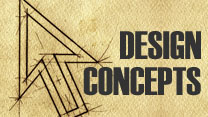Online courses directory (215)
Do you see yourself as a non-creative individual? Do you want to learn to effectively design and create sharper and more successful websites and graphics from the ground up? This course will teach the basics plus a whole lot more to help get you on the road to creating, designing and implementing solid designs for the web! In this introductory course, basic design thinking, theory and practice will be explored in an easy to absorb, fun and relaxed environment. Students will begin by understanding and implementing the foundations of design: the basic elements and principles of design. These elements and principles are applicable to all design mediums such as architecture, art, graphic design, photography, print and web design. Special emphasis will be given to the application of these principles and elements, along with color and typography, to the medium of web design. For students who have not had formal training in design, this course will bring them up to speed with the fundamentals of design, while learning how to apply these concepts to web and graphic design. For students who have received previous design training, this course will offer new techniques, tips and tricks, and new ways of thinking of design fundamentals while applying these concepts to the electronic mediums of web design and graphics for the web.
Combine fundamental concepts with hands-on design challenges to become a better designer.
Learn the basic concepts and approaches needed to understand, create, and perform contemporary music.
This course will guide graduate students through the process of using rapid prototyping and CAD/CAM devices in a studio environment. The class has a theoretical focus on machine use within the process of design. Each student is expected to have completed one graduate level of design computing with a full understanding of solid modeling in CAD. Students are also expected to have completed at least one graduate design studio.
This is an advanced subject in computer modeling and CAD CAM fabrication, with a focus on building large-scale prototypes and digital mock-ups within a classroom setting. Prototypes and mock-ups are developed with the aid of outside designers, consultants, and fabricators. Field trips and in-depth relationships with building fabricators demonstrate new methods for building design. The class analyzes complex shapes, shape relationships, and curved surfaces fabrication at a macro scale leading to new architectural languages, based on methods of construction.
Digital photography technology is continually changing, however, the principles behind good photography don't. ALISON's free online photo course gives you the opportunity to gain extensive knowledge and understanding of digital photography including topics such as exposure settings, how to read and use the histogram, how light affects a photograph, how the camera sensor and lenses work, and how to process a photograph using computer software. You will also learn tips and techniques on what not to do when taking a photograph. <br /><br />ALISON's free online course is ideal for those who wish to increase their understanding of digital photography and want to know how to process and produce photographs digitally.<br />
Intro to Animation. Incrementing Shortcuts. If Statements.
Mouse Interaction. mouseIsPressed. keyIsPressed. keyCode.
The aim of this course is to highlight some technical aspects of the classical tradition in architecture that have so far received only sporadic attention. It is well known that quantification has always been an essential component of classical design: proportional systems in particular have been keenly investigated. But the actual technical tools whereby quantitative precision was conceived, represented, transmitted, and implemented in pre-modern architecture remain mostly unexplored. By showing that a dialectical relationship between architectural theory and data-processing technologies was as crucial in the past as it is today, this course hopes to promote a more historically aware understanding of the current computer-induced transformations in architectural design.
Ecologies of Construction examines the resource requirements for the making and maintenance of the contemporary built environment. This course introduces the field of industrial ecology as a primary source of concepts and methods in the mapping of material and energy expenditures dedicated to construction activities.
This is a project to assist in the design, drawing, modeling and hopefully constructing of a small Community Children's Center near Guayaquil, Ecuador. For the last year, Nicki Lehrer, from MIT's Aero/Astro Department, has been organizing efforts to build the project. The goal of the workshop is to provide her with a full fleshed out design for the community center so it can be built in the summer of 2007.
Learn about the inspirational work of the leading European painters from approximately 1400 to 1800, and explore the issues expressed through the art of painting. Included in this broad time frame are the works of Leonardo da Vinci, Caravaggio, Velázquez, Rembrandt, Vermeer and Goya.
Painters during this period were concerned with ideas such as the pursuit of beauty, the pleasures and pains associated with love, the demonstration of power and status, or the relationship of men and women to the divinity and to nature. In paintings from this period, we find traces of the emergence of the modern mind set, and perspective on issues such as the respective roles of women and men in the world.
This course focuses on images of paintings by the artists listed in the course syllabus. The discussions that will take place in the “course forum” will allow us to touch upon a broader range of issues.
This course uses scale models to design environments that orchestrate contrasting material properties and conventional constructional systems to create places that foster specific ways of inhabiting space. It also demonstrates how architecture differs from other forms of design. Intended for students to test aptitude for architectural design and to experience an unfamiliar mode of thought, it's conducted in a studio format, with lectures on architectural theory and history, and structured for students with no previous experience in design.
Required of Architecture majors.
A series of lectures on one of the greatest bodies of music ever composed, from the point of view of a performer. Each lecture will explore a different facet of the music; all will attempt to locate the source of the tremendous psychological power of Beethoven’s music.
Inspired by the work of the architect Antoni Gaudi, this research workshop will explore three-dimensional problems in the static equilibrium of structural systems. Through an interdisciplinary collaboration between computer science and architecture, we will develop design tools for determining the form of three-dimensional structural systems under a variety of loads. The goal of the workshop is to develop real-time design and analysis tools which will be useful to architects and engineers in the form-finding of efficient three-dimensional structural systems.
Explore eight important works from different eras and genres of Western classical-music repertoire, through performances recorded at Curtis and discussion of each work’s historical context, composer, musical significance, and compositional design.
In this course students learn the basic concepts of acoustics and electronics and how they can applied to understand musical sound and make music with electronic instruments. Topics include: sound waves, musical sound, basic electronics, and applications of these basic principles in amplifiers and speaker design.
This design-based subject provides a first course in energy and thermo-sciences with applications to sustainable energy-efficient architecture and building technology. No previous experience with subject matter is assumed. After taking this subject, students will understand introductory thermodynamics and heat transfer, know the leading order factors in building energy use, and have creatively employed their understanding of energy fundamentals and knowledge of building energy use in innovative building design projects. This year, the focus will be on design projects that will complement the new NSTAR/MIT campus efficiency program.
This course will introduce students to the theory of music, providing them with the skills needed to read and write Western music notation, as well as to understand, analyse, and listen informedly. It will cover material such as pitches and scales, intervals, clefs, rhythm, form, meter, phrases and cadences, and basic harmony.
Trusted paper writing service WriteMyPaper.Today will write the papers of any difficulty.



















